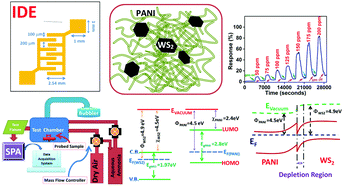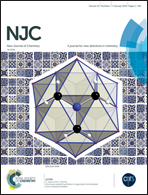Ammonia vapour sensing properties of in situ polymerized conducting PANI-nanofiber/WS2 nanosheet composites†
Abstract
Polyaniline (PANI)/inorganic-nanomaterial based nanocomposites are attractive for gas sensing applications due to the synergistic behavior arising at their interfaces. In this work, HCl doped-PANI-nanofibers/WS2 nanosheet based nanocomposites were prepared by the template-free in situ polymerization of aniline on WS2 nanosheets, which were previously obtained by direct liquid exfoliation. The optimal performance was shown by the PANI/WS2 (w/w 10%) sample and it was characterized extensively using electron microscopy (SEM and TEM), several spectroscopic techniques (UV-Vis, Raman and FTIR), and X-ray diffraction. The nanomaterial was deposited on gold interdigitated electrodes which were then used as chemiresistive transducers for ammonia sensing at room temperature. The device was tested for ammonia concentrations of 50–200 ppm. The resistance of the device was found to increase with the concentration of ammonia vapours and a maximum response of up to 81% was recorded for 200 ppm of ammonia. The long-term stability, selectivity, sensitivity, and repeatability of the device were investigated. Apart from these, the device was also found to perform well under humid conditions. A mechanism based on the synergistic behavior due to the p–n heterogeneous characteristics at the interface of PANI and WS2 is proposed.



 Please wait while we load your content...
Please wait while we load your content...